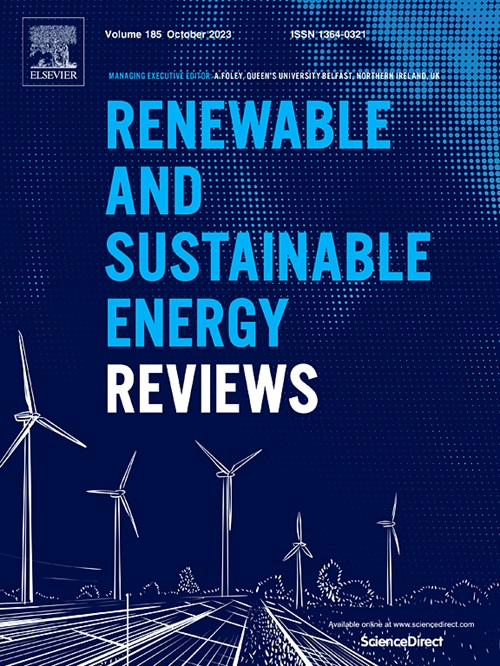Data-driven wind farm flow control and challenges towards field implementation: A review
IF 16.3
1区 工程技术
Q1 ENERGY & FUELS
引用次数: 0
Abstract
Data-driven wind farm flow control (WFFC) is an innovative approach that leverages the collected data and advanced analytics to enhance the performance of wind turbines within wind farms. Its significance lies in its ability to adapt to changing wind and turbine conditions and improve operations, boosting energy yield, extending turbine/component lifetime, and potentially reducing socio-environmental impact and costs, thus supporting the viability and sustainability of wind energy as a renewable power source. This review explores the dynamic field of data-driven WFFC and its challenges towards practical implementation. Building on top of traditional wind farm modelling and model-based control, it details the virtues and limitations of these methods while introducing the concept of data-informed or data-driven flow models that harness data to augment predictive accuracy and control strategies. The analysis then covers the methodologies for power and load surrogates, elucidating the pivotal role of surrogate modelling in enhancing WFFC, and showcasing its value in decision-making and energy optimisation. Furthermore, the growing field of reinforcement learning (RL) is highlighted, showcasing its adaptive potential to revolutionise wind farm control through learning from past interactions. The investigation concludes by identifying key challenges impeding the practical deployment of data-driven WFFC, including data quality concerns, cybersecurity risks, and limitations of the current algorithms. In summary, this comprehensive review presents the ongoing development of data-driven WFFC, emphasising the synergy between traditional methods, surrogate modelling, RL, and the critical challenges to be addressed for successful integration of these methodologies in real-world wind farm operations.

求助全文
约1分钟内获得全文
求助全文
来源期刊

Renewable and Sustainable Energy Reviews
工程技术-能源与燃料
CiteScore
31.20
自引率
5.70%
发文量
1055
审稿时长
62 days
期刊介绍:
The mission of Renewable and Sustainable Energy Reviews is to disseminate the most compelling and pertinent critical insights in renewable and sustainable energy, fostering collaboration among the research community, private sector, and policy and decision makers. The journal aims to exchange challenges, solutions, innovative concepts, and technologies, contributing to sustainable development, the transition to a low-carbon future, and the attainment of emissions targets outlined by the United Nations Framework Convention on Climate Change.
Renewable and Sustainable Energy Reviews publishes a diverse range of content, including review papers, original research, case studies, and analyses of new technologies, all featuring a substantial review component such as critique, comparison, or analysis. Introducing a distinctive paper type, Expert Insights, the journal presents commissioned mini-reviews authored by field leaders, addressing topics of significant interest. Case studies undergo consideration only if they showcase the work's applicability to other regions or contribute valuable insights to the broader field of renewable and sustainable energy. Notably, a bibliographic or literature review lacking critical analysis is deemed unsuitable for publication.
 求助内容:
求助内容: 应助结果提醒方式:
应助结果提醒方式:


